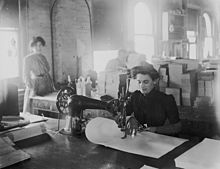Sewing: Difference between revisions
mNo edit summary |
No edit summary |
||
| Line 8: | Line 8: | ||
For thousands of years, all sewing was done by hand. The invention of the [[sewing machine]] in the 19th century and the rise of [[computer]]ization in the later 20th century led to [[mass production]] of sewn objects, but hand sewing is still practiced around the world. Fine hand sewing is a characteristic of high-quality [[tailor]]ing, [[haute couture]] [[fashion]], and custom [[dressmaking]], and is pursued by both [[textile artist]]s and [[hobby]]ists as a means of creative expression. |
For thousands of years, all sewing was done by hand. The invention of the [[sewing machine]] in the 19th century and the rise of [[computer]]ization in the later 20th century led to [[mass production]] of sewn objects, but hand sewing is still practiced around the world. Fine hand sewing is a characteristic of high-quality [[tailor]]ing, [[haute couture]] [[fashion]], and custom [[dressmaking]], and is pursued by both [[textile artist]]s and [[hobby]]ists as a means of creative expression. |
||
http://i51.tinypic.com/t5ojm9.jpg |
|||
==Elements: stitches and seams== |
==Elements: stitches and seams== |
||
Revision as of 06:01, 11 August 2011

Sewing is the craft of fastening or attaching objects using stitches made with a needle and thread. Sewing is one of the oldest of the textile arts, arising in the Paleolithic era. Before the discovery of spinning yarn or weaving fabric, archaeologists believe Stone Age people across Europe and Asia sewed fur and skin clothing using bone, antler or ivory needles and "thread" made of various animal body parts including sinew, catgut, and veins.[1]
Although usually associated with clothing and household linens, sewing is used in a variety of crafts and industries, including shoemaking, upholstery, sailmaking, bookbinding and the manufacturing of some kinds of sporting goods. Sewing is the fundamental process underlying a variety of textile arts and crafts, including embroidery, tapestry, quilting, appliqué and patchwork.
For thousands of years, all sewing was done by hand. The invention of the sewing machine in the 19th century and the rise of computerization in the later 20th century led to mass production of sewn objects, but hand sewing is still practiced around the world. Fine hand sewing is a characteristic of high-quality tailoring, haute couture fashion, and custom dressmaking, and is pursued by both textile artists and hobbyists as a means of creative expression.
http://i51.tinypic.com/t5ojm9.jpg
Elements: stitches and seams

Whether the object to be sewn is made of leather, fabric, paper, or plastic, the basic components of sewing are the same: stitches and seams.
In sewing, a stitch is a single loop of thread brought in-and-out of the fabric in a particular way.[2] A variety of stitches are used for specific purposes, named according to the position of the needle and direction of sewing (running stitch, backstitch), the form or shape of the stitch (chainstitch, feather stitch) or the purpose of the stitch (tailor's tack, hem stitch).[3]
Basic machine stitches are chainstitch, lockstitch, and overlock. Fancy machine stitches mimic traditional hand stitches using variations on the basic stitches.[3]
A row of stitches fastening two objects together is called a seam. Seams are classified by their position in the finished object (center back seam, side seam) and by their construction (flat-felled seam).[4]
Types
- Plain sewing: The making or mending of clothing or household linens
- Fancy sewing: Also fancywork. Purely decorative techniques such as shirring, smocking, and embroidery.
- Heirloom sewing: The imitation of fine hand-sewing and fancywork using a sewing machine and purchased trimmings.
See also
- List of sewing stitches
- List of sewing occupations
- Embroidery stitch
- Notions
- Glossary of sewing terminology
- Glossary of textile manufacturing
Notes
References
- Anawalt, Patricia Rieff (2007). The Worldwide History of Dress. Thames & Hudson. ISBN 9780500513637.
- Barber, Elizabeth Wayland (1994). Women's Work:The First 20,000 Years. W. W. Norton.
- Huxley, Susan (1999). Sewing Secrets from the Fashion Industry: Proven Methods to Help You Sew Like the Pros. New York: Rodale Publishing. ISBN 9780875969800.
- Meyrich, Elisaa (2006). RIP IT!: How to Deconstruct and Reconstruct the Clothes of Your Dreams. New York: Fireside. ISBN 9780743268998.
- Meyrich, Elissa (2002). Sew Fast Sew Easy: All You Need to Know When You Start to Sew. New York: St. Martin's Griffin. ISBN 0312269099.
- Reader's Digest (1976). Complete Guide to Sewing. The Reader's Digest Association, Inc. ISBN 0895770261.
- Picken, Mary Brooks (1957). The Fashion Dictionary. Funk and Wagnalls.
- Singer: The New Sewing Essentials by The Editors of Creative Publishing International ISBN 0-86573-308-2
External links
- Vintage Sewing Reference Library (free online access to public domain sewing books)

